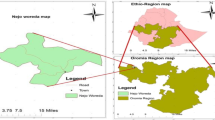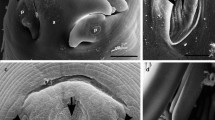Abstract
ALTHOUGH the second ecdysis of certain species of nematodes which parasitize sheep is known to take place in the alimentary tract of the host, the actual site is not definitely known. In the horse, some knowledge of this subject has been gained by placing larvæ in fluid from various parts of the intestinal tract1; but this method has not always been successful with sheep. However, it has been reported that the abomasal fluid plays a part, at least in so far as Haemonchus contortus 2, Trichostrongylus colubriformis 3 and T. rugatus 3 are concerned.
This is a preview of subscription content, access via your institution
Access options
Subscribe to this journal
Receive 51 print issues and online access
$199.00 per year
only $3.90 per issue
Buy this article
- Purchase on Springer Link
- Instant access to full article PDF
Prices may be subject to local taxes which are calculated during checkout
Similar content being viewed by others
References
Poynter, D., Nature, 173, 781 (1954).
Veglia, F., Rep. Vet. Res. S. Afr., 3–4, 349 (1915).
Monnig, H. O., Rep. Vet. Res. S. Afr., 11–12, 231 (1926).
Veglia, F., Rep. Vet. Res. S. Afr., 9–10, 811 (1923).
Tetley, J. H., N.Z. J. Sci. Tech., 18, 805 (1937).
Author information
Authors and Affiliations
Rights and permissions
About this article
Cite this article
SOMMERVILLE, R. The Second Ecdysis of Infective Nematode Larvæ. Nature 174, 751–752 (1954). https://doi.org/10.1038/174751a0
Issue Date:
DOI: https://doi.org/10.1038/174751a0
This article is cited by
-
Heat shock, but not temperature, is a biological trigger for the exsheathment of third-stage larvae of Haemonchus contortus
Parasitology Research (2018)
-
Development of Graphidium strigosum (Nematoda, Haemonchidae) in its natural host, the rabbit (Oryctolagus cuniculus) and comparison with several Haemonchidae parasites of ruminants
Parasitology Research (2011)
-
Effect of a Coliform Organism (Escherichia) on the Second Ecdysis of Nematode Larvæ parasitic in the Horse
Nature (1956)
Comments
By submitting a comment you agree to abide by our Terms and Community Guidelines. If you find something abusive or that does not comply with our terms or guidelines please flag it as inappropriate.



